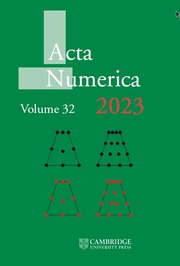Article contents
Distributionally robust optimization
Published online by Cambridge University Press: 01 July 2025
Abstract
Distributionally robust optimization (DRO) studies decision problems under uncertainty where the probability distribution governing the uncertain problem parameters is itself uncertain. A key component of any DRO model is its ambiguity set, that is, a family of probability distributions consistent with any available structural or statistical information. DRO seeks decisions that perform best under the worst distribution in the ambiguity set. This worst case criterion is supported by findings in psychology and neuroscience, which indicate that many decision-makers have a low tolerance for distributional ambiguity. DRO is rooted in statistics, operations research and control theory, and recent research has uncovered its deep connections to regularization techniques and adversarial training in machine learning. This survey presents the key findings of the field in a unified and self-contained manner.
MSC classification
Information
- Type
- Research Article
- Information
- Creative Commons
- This is an Open Access article, distributed under the terms of the Creative Commons Attribution licence (http://creativecommons.org/licenses/by/4.0/), which permits unrestricted re-use, distribution, and reproduction in any medium, provided the original work is properly cited.
- Copyright
- © The Author(s), 2025. Published by Cambridge University Press
References
- 11
- Cited by

